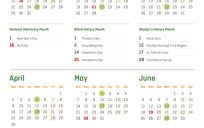At EPA, we’ve started using regular heat maps to experiment and assess success on our home page. These visual presentations show where people are clicking – hotter colors mean more clicks.
Every month, we update our popular topics list based on what people are searching for. We also often try out new features. So we also do a heat map run every month. For example, over the past few months we’ve moved around the popular topics and we’ve added a map with links to regional content.
I just compared the heat map from November 2009 to the one just completed, and I’m pretty pleased. The stuff at the top hasn’t changed, and it’s still clicked a lot. But many other areas are being clicked a lot more (more intense colors in more places). I interpret that as meaning that more people are finding what they want on our home page.
Neither the tool nor the page are perfect, of course. And there’s plenty of other stuff we look at and consider. And not everyone will agree with our overall design (I know some folks think our banners are too big). But it’s nice, now and then, to get a sense you’re moving in the right direction.
November 2009 (Download 7MB PDF)

January 2011 (Download 7MB PDF)




Good stuff, Jeffrey! What software does EPA use to generate the maps?
Adriel, it’s called Crazy Egg. It also produces other displays. I’ve also heard that Google Analytics does similar things.
OMG – That’s awesome sauce! (Begins frantic google search)
This is cool.
I like that the map got all lit up. Do you have larger versions of these pics?
Gazehawk is another service I used. Here is the GovLoop home page in a picture – would love any ideas/thoughts
Random question – how many people come to home page vs other pages (maybe coming via search/newsletter/social media links)? I’ve been thinking about GL home page but noticed lots of our folks aren’t coming to our home page but directly to an article/group via our newsletter/Twitter or Facebook/ or search
Adriel: I just figured out how to attach the full-size PDFs, so use the links at the top of each image. 🙂
Jeffrey – Was talking to Andrew/Micah of Tech President and we were talking Me vs We government. Concept being that most citizens want is Me government (where do I download a form, file taxes, get information on a grant, look for job). But gov’t is starting to want more We gov (your feedback on our plans, dialogue, 2-way collaboration, etc).
Goes into the Twitter discussion we had the other day re: what percent of citizens want to engage VS just consumer.
Any sense from analytics how that breaks down?
Doesn’t diminish the awesome importance of engagement… just thinks through what’s realistic and how that audience is difference. Like Starbucks – maybe 95% of folks don’t care enough to give Starbucks Ideas and submit new ideas (they just want their coffee) but a passionate 5% do want to share ideas (and how do we find them, engage them, treat them differently)
Steve: your question about home page vs. the rest of the site is a good one.
At EPA, the home page is the most popular single page by FAR. Over the past 30 days, it was viewed 384,000 times, as compared to the next three most popular, with 54,000, 37,000, and 31,000 views.
But even that’s tiny compared to the 13 million views across the site last month.
So I find myself trying to improve the home page while keeping most of our attention on improving the site as a whole.
As for your eyetracking map, I’d use it the same way as heat maps: note the red areas and devote most of your attention to improving how those work. Note the blank areas and either stop doing them or be sure not to spend much time on them.
And if you’re interested in an experiment, try it out, do a run, and see what happened, then adjust.
Steve: I think delivering the info people want is always going to be the vast majority of our goal online.
Engagement is for specific things: policy input, ideas for what people can do themselves, etc. And that’s going to be a small slice of the citizenry.
For example, I plan to put most of our effort into things like improving how we deliver info about regs. But some amount will also go into improving the mechanisms by which interested people can help us think through proposed regs.
Love it.
Any thoughts on this government engagement funnel I’ve been working on which talks about that (from seeking info to high-level asks that are important like regulation input)? We see it on GovLoop and trying to look at other problems and seeing if similar
https://www.govloop.com/profiles/blogs/my-4-part-government